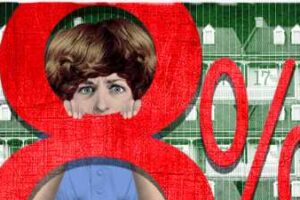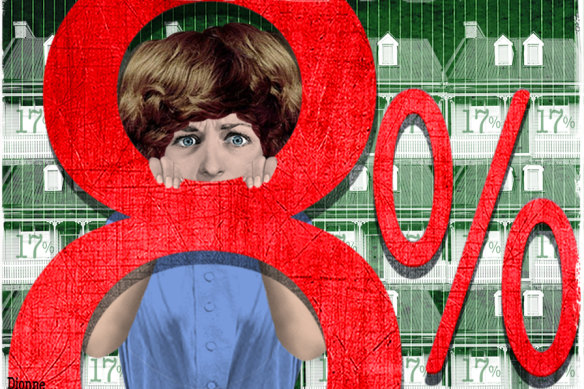Forget 17 per cent: Borrowers are now officially hurting more than the 1980s

Save articles for later
Add articles to your saved list and come back to them any time.
Six years ago, almost to the day, I wrote a column for this publication with the headline: ‘Mortgage warning: 8 per cent is the new 17 per cent’. Well, guess what?
We have just hit 8 per cent, or we have according to the RBA’s latest standard variable indicator rate.
Making the mortgage was super tough in the late ’80s and early ’90s. It is now equally tough, at best.Credit: Dionne Gain
The painful mortgage milestone took a little longer than forecast – a global pandemic put it on ice for a while. But it means that today, the repayment pain is even worse than predicted.
Let’s take a trip down money memory lane to the late 1980s and early 1990s.
The RBA’s indicator rate stayed at 17 per cent for 10 excruciating months. And I’ve spoken to half a dozen people this week who recalled, eyes almost filling, their rate pushing to more like 20 per cent.
We are talking averages here – and everyone reading and remembering will be different – but the typical loan size averaged across those 10 months was $67,350 and the average salary was $26,437, according to ABS data.
That’s a loan-to-take-home multiple of 2.5 times. Fast-forward to today and the numbers are so large as to be intimidating but what matters is not their size but their relativity.
The average loan is now $586,366 and the wage is $93,907. One or both of those stats may have made you choke on your homemade avocado toast. The great Australian dream multiple has leapt to 6.2 times.
So how much do our repayments hurt, then?
At an interest rate of 17 per cent in 1989/90, the mortgage consumed 44 per cent of income. Our 8 per cent interest rate today devours a gut-punching 58 per cent of our income.
Now, anyone paying assiduous attention to their mortgage should be screaming that you can still do way better than an 8 per cent interest rate. And if you’re paying that you are presumably not just a home-loan hostage – in other words, unable due to income or equity to refinance – but stuck with a terrible lender.
You can think of the RBA indicator rate as more like a mortgage benchmark from which borrowers often get discounts.
In fact, data house Mozo put the discounted average rate loans with genuine offset accounts at 5.91 per cent before last week’s rate rise. It will be 6.16 per cent within weeks (lenders will lift on different dates).
Even at that far-better rate, though, the mortgage cut of your money is 49 per cent, versus the 1989/90 take of 44 per cent.
What if we level the playing field further and run the three-plus-decades-ago numbers on 20 per cent? They almost equalise at 51 per cent then versus 49 per cent now.
I lamented in my 2017 column about the danger of 8 per cent: “Such has been the failure of wages to keep pace with the spectacular growth in property prices… yet a (grudging) national willingness to use debt to chase them.”
Six years on, things haven’t improved. The average loan for a house in mid-2017? Only $380,000, $206,366 below the typical debt today. Meanwhile, the average income was $79,721. So people were borrowing about five times that income for a home.
So how extreme is today’s situation? Housing stress is defined as when the roof over your head costs more than one-third of your salary. The average Aussie is well past that.
The hikes also mean something sobering long-term: we are almost exactly at the interest rate that doubles the amount you will ultimately pay for your home. That’s not 6.16 per cent but 6.36 per cent.
If you borrow $586,366 for your property it will cost you the same again in interest, pushing your bill to $1,172,732. That’s, of course, only if you take your contracted assumed 25 years to pay it off – and you should be using all the strategies at your fingertips to ditch your debt quick.
But rate rises may mercifully stop before we quite get there. Of the 42 economists and experts who participate in Finder’s Cash Rate survey, three in four expect the Reserve to hold rates steady next month.
Many have, in fact, long forecast the top terminal cash rate as where it sits now: 3.85 per cent.
Borrowers are stuck up here, however, some losing 49 per cent of their income for at least a while longer.
Commsec’s post-increase update said: “We continue to expect 50 basis points of rate cuts in the fourth quarter of 2023 and a further 50 basis points of easing in the first half of 2024 as policy is taken to a more neutral level.”
“Kids these days,” is a phrase that gets lobbed around a lot. Or some judgemental equivalent.
When it comes to a home, the follow-up is often that this generation: “…don’t know how to tighten their belts”, “…expect to buy too fancy”, “…aren’t willing work their way up”.
Maybe. But here we are with still-exorbitant house prices, virtually stagnant wages and suddenly, brutally higher interest rates. Making the mortgage was super tough in the later ’80s and early ’90s.
It is now equally tough, at best.
- Advice given in this article is general in nature and is not intended to influence readers’ decisions about investing or financial products. They should always seek their own professional advice that takes into account their own personal circumstances before making any financial decisions.
Nicole Pedersen-McKinnon is the author of How to Get Mortgage-Free Like Me. Follow Nicole on Facebook, Twitter or Instagram.
Most Viewed in Money
From our partners
Source: Read Full Article

